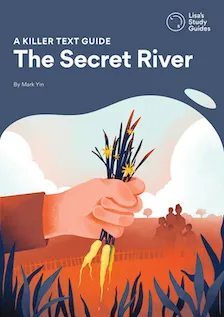This blog was updated on 21/10/2020.
Contents
1. Summary
2. Background
3. Setting
4. Chapter 1 Plot and Analysis
5. Themes
6. Quotes
7. Sample Essay Topics
8. Essay Topic Breakdown
The Secret River is usually studied in the Australian curriculum under Area of Study 1 - Text Response. For a detailed guide on Text Response, check out our Ultimate Guide to VCE Text Response.
Summary
The Secret River is a historical novel telling the story of William Thornhill, a poor Englishman from the early 19th century who was deported and transported to New South Wales, Australia in 1806 for theft. This novel tells the story of Australia's founding and the moral choices made when Europeans colonised land that was already inhabited by Aboriginal people.
Background
During 18th century to mid 19th century, 162,000 men and women were transported to Australia, with majority from England. These people, known as ‘convicts’, had committed crimes such as larceny and robbery – acts which were considered severe offenses and demanded heavy sentences. In order to deal with the overwhelming masses of criminals, the government exported crowds of convicts to Australia to serve their term as labourers. The reason driving the deportation included an attempt to decrease poverty and crime in England while concurrently developing the British colony in Australia.
Many of the fleets from England were destined for New South Wales, Australia. Those on the fleets included the criminals, marines, and their families. Living in a penal colony, the criminals were employed depending on their various skills: farmer, boatman, servant etc. The settlers were award a ‘ticket of leave’ if they presented good behaviour during labour. This meant that settlers would become emancipists, where they were set free from the government’s sentence and could begin a life for themselves by making their own living. This suited the government’s goal for a successful and thriving colony since it would only be possible if people were to work for themselves, and not under the terrain of the government.
Although Australia was chiefly populated with Indigenous Australians, the first century of colonisation saw a drastic decline in their population. This was due to a clash of desire for the land; the native’s innate protection of their land and the white settlers struggle to declare their right to an area already inhibited by natives – possibly for 40,000 years. The two cultures failed to ever create a peace agreement or compensation and as a result, the frontier was often marked with blood. Overtime, a successful of the British colony meant that white settlement overpowered any possibility of the natives retaining their land. The Secret River’s exploration of this powerful change in Australia’s history is a poignant reflection of the past, and demands attention to the sensitive issue of Australian and native relationship that is still present today.
Setting
Set during the early 19th century. Located in London, Sydney and on the Hawkesbury.
Chapter 1: Strangers
Plot
The Alexander, a transport ship for convicts has reached New South Wales, Australia after a travelling across the world for majority of the year. William Thornhill, an Englishman convicted to sentence his ‘natural life in the Year of Our Lord eighteen hundred and six’ [pg 3] will serve as a labourer.
During his first night in New South Wales, where their homes are ‘only a flap of bark, a screen of sticks and mud,’ Thornhill digested the new land with its ‘rich dank smells…restless water…no Pole star’; an environment vastly differentiated from England. The unfamiliar situation is overwhelming as ‘he had not cried, not for thirty years….but now his throat was thickening.’ In his despair, Thornhill describes how being sentenced to New South Wales could potentially be worse than dying itself.
Initially, Thornhill believed his tears are clouding his vision since the ‘darkness moved in front of him’ [pg 5]. However, he then realised that a human, ‘as black as the air itself’ stood before him. The unusual appearance of this human struck Thornhill since ‘his skin swallowed the light…[and] eyes were set so deeply into the skull.’ Although clothed, Thornhill ironically felt ‘skinless’ against the other who was completely naked and holding a spear. Thornhill repeatedly demanded that the man ‘be off’, for fear of his family and himself being attacked. Despite his shouting, this only impelled the man to move closer to the point where they almost touched. The ‘black man’ [pg 6] reproduced ‘be off’ in Thornhill’s exact tone. While Thornhill’s fear of this strange human is prominent, he grappled the strength to exert a bold, intrepid veneer, as ‘he was not about to surrender to any naked black man’. When he glanced back to his wife and children however, the man promptly disappeared, leaving only the darkness behind. Thornhill returned to his hut where he laid back down to rest yet ‘every muscle was tensed…the cold moment of finding that unforgiving thing in his flesh.’
Analysis
Environmental / Landscape conflict
For Thornhill, who has spent a lifetime in England, the confrontation of a new environment evokes a powerful sense of unfamiliarity. The unknown land presents him with various intrapersonal conflicts, one of which is the difference between England and Australian stars. While the physical distance of this new land from Thornhill’s home is demonstrated by the lack of a ‘Pole Star, a friend to guide him on the Thames, [and] no Bear that he had known all his life,’ [pg 4] the unrecognisable stars above Australia only depict a ‘blaze, unreadable, [and] indifferent.’ His conflict demonstrates his physical and emotional distance from Thames, a place he grown up surrounded by compared to Australia, where learning begins from the very basics, as shown when he absorbs the natural landscape around him. The night described as ‘huge and damp, flowing in and bringing with it the sounds of its own life’ [pg 3] highlights how the Australian land is unique, possessing qualities of existence.
Thornhill’s sense of negligence in the vast forest that continues ‘mile after mile’ is illustrated through the imagery of the ‘trees [which] stood tall over him,’ depicting that nature is a powerful and dominant force over the Europeans. While the trees render him insignificant, it also demonstrates his alienation from the environment. The ‘Alexander,’ a common traditional English name, represents an intrusion of the Europeans onto the Australian land, further highlighting the idea that they do not belong on this island.
The Australian land is depicted to be harsh and unforgiving, as highlighted through the imagery of ‘dirt chill...sharp stab...alien stars' [pg 4] This conflict with the brutal landscape, along with the unknown leaves Thornhill apprehensive of what is to come. His feeling that he was ‘nothing more than a flea on the side of some enormous quiet creature’ [pg 4] depicts the Australian land almost like a monster. Additionally, the words ‘restless’ draw to the idea that the land is at discomfort or uneasy to have new inhabitants.
Racial/Cultural conflict
The conflict between two cultures is shown through the initial encounter between Thornhill and an Indigenous Australian. Without any conversation, the tension between the two is clear, merely through their actions in each other’s prescence. Thornhill notes the Aboriginal male’s tattoos, yet regards them as ‘scars’ since he is unaware to their culture. Even before this man, Thornhill is still infused with a sense of nakedness because of his unfamiliarity. His feeling that ‘every muscle was tensed…the cold moment of finding that unforgiving thing in his flesh’ highlights the tension of his first encounter of an Australian Aboriginal while it also foreshadows a suffering and anguish for his time ahead.
If you'd like to see the all Chapter plots, their analysis, along with important quotes, then have a look at our The Secret River Study Guide.
Quotes
Conflict with land quotes
“Now it had fetched up at the end of the earth.” [pg 3]
“…this prison whose bars were ten thousand miles of water.” [pg 3]
“foreign darkness” [pg 3]
“…soughing of the forest, mile after mile.” [pg 3]
“He was nothing more than a flea on the side of some enormous quiet creature.” [pg 4]
Thornhill’s inner conflict quotes
“He had not cried, not for thirty years, not since he was a hungry child to young to know that crying did not fill your belly.” [pg 4]
“But every muscle was tensed, anticipating the shock in his neck or his belly, his hand going to the place, the cold moment of finding that unforgiving thing in his flesh.” [pg 6]
Racism quotes
“It took a moment to understand that the stirring was a human, as black as the air itself.” [pg 5]
“Clothed as he was, Thornhill felt skinless as a maggot.” [pg 5]
“This was a kind of madness, as if a dog were to bark in English.” [pg 6]
“He was not about to surrender them to any naked black man.” [pg 6]
Sample Essay Topics
1. William Thornhill is more worthy of our respect than our reprehension. Do you agree?
2. How does Kate Grenville explore hierarchy?
3. How does The Secret River’s symbolism enhance its exploration of alienation?
4. “Fear could slip unnoticed into anger, as if they were one and the same.” The Thornhills’ anger is valid. To what extent do you agree?
Now it's your turn! Give these essay topics a go. For more sample essay topics, head over to our The Secret River Study Guide to practice writing essays using the analysis you've learnt in this blog!
Essay Topic Breakdown
Whenever you get a new essay topic, you can use LSG’s THINK and EXECUTE strategy, a technique to help you write better VCE essays. This essay topic breakdown will focus on the THINK part of the strategy. If you’re unfamiliar with this strategy, then check it out in How To Write A Killer Text Response.
Within the THINK strategy, we have 3 steps, or ABC. These ABC components are:
Step 1: Analyse
Step 2: Brainstorm
Step 3: Create a Plan
Theme-Based essay prompt: The Secret River depicts many layers of conflict, within but also between its key characters. Discuss
Step 1: Analyse
The key term of this prompt is conflict, but I think it’s also important to analyse how it’s discussed—as something that exists in layers, and something that can happen both within and between characters. This seems to hint at the idea that conflict can be internal—that is a single character can feel conflicted about something—as well as external—that is two or more characters can have some kind of dispute. This prompt will require us to think about all these different types of conflict.
Step 2: Brainstorm
Let’s start with the most internal layer—conflicts with the self. In terms of key characters, consider William but also Sal: what debates do they have with themselves, or what do they say or do that shows they feel conflicted or unsure about something?
Then, let’s broaden that out to interpersonal conflicts between characters. How do William and Sal, for example, come into conflict with their neighbours—both their white neighbours and their Aboriginal neighbours? How do they come into conflict with each other, even?
Maybe it’s worth separating the racial conflict into another category—conflicts between groups of characters, rather than individual characters. If we make this distinction, we need to be prepared to back it up—in what ways is this conflict of a different nature?
Step 3: Create a plan
I think we can pretty justifiably separate out our layers of conflict into those categories: interpersonal, interpersonal and interracial. This gives us three neat(-ish) paragraphs and a clear, affirmative contention: yes, there are many layers of conflict, and those are the three layers.
P1: At its most intimate layer, conflict is internal—the moral dilemmas of William and Sal are particularly strong examples.
P2: Conflict can also be interpersonal—we can see this between William and Dan, or William and his neighbours, or between William and Sal even. It’s up to you which way you cut this paragraph.
P3: However, perhaps the central conflict that the novel is built around is interracial conflict between white colonisers and the Aboriginal people whose land they occupied. To extend the prompt a little, we can talk about conflict not just between characters or people, but also between value systems. For example, the way colonisers saw land and property were fundamentally incompatible with how Aboriginal people saw it—this is another type of conflict.
In this sense, we’re largely agreeing with the prompt, backing up the distinction between interpersonal and interracial conflict, and finding a way to extend on it a little towards the end. We can build this into the contention as well: there are many layers of conflict, but they occur not just between characters. They can also exist between the broad cultural values of entire groups of people as well.
If you find this essay breakdown helpful, then you might want to check out our The Secret River Study Guide where we cover 5 A+ sample essays (written by a 50 study scorer!) with EVERY essay annotated and broken down on HOW and WHY these essays achieved A+ so you reach your English goals! Let's get started.
Resources
The Ultimate Guide to VCE Text Response
How To Write A Killer Text Response Study Guide
How to embed quotes in your essay like a boss






.webp)
%2520(1)%2520(1).webp)
%2520(1)%2520(1)%2520(1).webp)
%2520(1).webp)
%2520(1).webp)
%2520(1)%2520(1)%2520(1).webp)
%2520(1)%2520(1)%2520(1).webp)
%2520(1)%2520(1).webp)
%2520(1)%2520(1)%2520(1).webp)
.webp)
%2520(1).webp)
%2520(1).webp)
%2520(1).webp)
%2520(1)%2520(1)%2520(1)%2520(1).webp)
%2520(1)%2520(1)%2520(1).webp)
.webp)
.png)
.png)
%20copy.jpg)
.png)
.png)
.png)








.jpg)